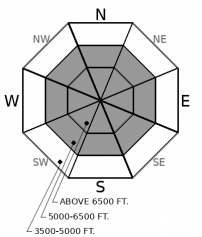| Tuesday | Tuesday Night | Wednesday | |
|---|---|---|---|
| Cloud Cover: | Mostly Cloudy | Mostly Cloudy | Mostly Cloudy |
| Temperatures: | 16 to 26 deg. F. | 5 to 15 deg. F. | 15 to 25 deg. F. |
| Wind Direction: | Variable | West | Southwest |
| Wind Speed: | 3 to 6 mph | 4 to 8 mph | 6 to 10 mph, gusting to 24 mph |
| Snowfall: | 0 in. | 0 in. | Trace to 1 in. |
| Snow Line: | 1000 ft | 500 ft | 500 ft |
Whitefish Range
Swan Range
Flathead Range and Glacier National Park
How to read the forecast

2. Moderate
?
Above 6500 ft.
2. Moderate
?
5000-6500 ft.
1. Low
?
3500-5000 ft.
- 1. Low
- 2. Moderate
- 3. Considerable
- 4. High
- 5. Extreme
-
Type ?
-
Aspect/Elevation ?

-
Likelihood ?CertainVery LikelyLikelyPossible
 Unlikely
Unlikely -
Size ?HistoricVery LargeLargeSmall

Observers continue to experience collapsing and cracking as buried weak layers fail under our weight. Persistent slabs are difficult to predict. They can be remotely triggered from shallow areas and produce unusually wide avalanches where the slab stretches across the slope. Careful terrain selection is the easiest way to manage this problem. Steep wind-loaded and cross-loaded slopes worry us the most. Adjacent rocky terrain features with variable coverage are likely trigger points. Sheltered, gladed slopes are a safer option.
It seems like little has changed throughout our area since the last snow fell on the 23rd. But as visions of steep terrain begin to dance in your head, remember that weak layers persist in our snowpack likes lumps of coal at the bottom of our stocking.
There have been no reports of avalanches involving these layers since last Tuesday's storm. Yesterday, we received several reports of sudden collapses in the Whitefish Range and Glacier Park. Audible whumphs and shooting cracks are direct feedback from buried weak layers that they can fail under your weight. Recent stability tests have shown the propagation potential of these layers (Example 1, Example 2, Example 3).
Managing persistent slabs requires patience and careful terrain selection. This problem is most pronounced on steep wind-drifted and crossloaded features. It is also found in rocky areas with variable coverage. Slopes sheltered from the effects of the wind offer a safer option.
We are offering an Avalanche Awareness talk Thursday, December 27 at Stumptown Snowboards at 7:00 p.m.! We are offering a Motorized Level 1- Avalanche Fundamentals course January 11-13!
It will be a quiet Christmas in Northwest Montana. A weak disturbance will track south of us today followed by a brief ridge of high pressure building overhead tomorrow. Occasionally, very light snowfall will be possible, but there will be little accumulation.
This forecast applies only to backcountry areas outside established ski area boundaries. The forecast describes general avalanche conditions and local variations always occur. This forecast expires at midnight on the posted day unless otherwise noted. The information in this forecast is provided by the USDA Forest Service who is solely responsible for its content.




















